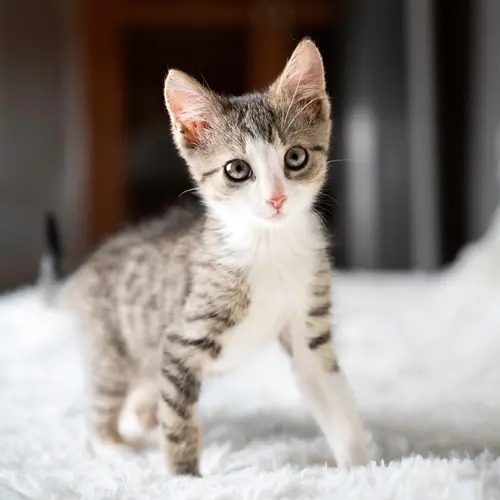Rabbits are a popular household pet in the United States. When you think of pet rabbits, you probably imagine the standard fluffy, gray, floppy-eared rabbit. But there are many unique rabbit breeds recognized by the American Rabbit Breeders Association. One of these is the American Chinchilla Rabbit.
You may be confused about the name of this breed — after all, rabbits and chinchillas are two very different animals. These docile animals were bred into existence in 1919 in France for meat and their pelts. Their name refers to the color and texture of their fur, similar to a chinchilla’s fur.
Once a popular breed, especially in the meat and rabbit fur industries, the American Chinchilla Rabbit is considered rare nowadays. The American Livestock Breeds Conservancy has listed them as critical on the endangered breeds list.
These rabbits are beautiful and make good pets. They are hardy animals with a gentle nature, making them perfect for first-time pet owners.
American Chinchilla Rabbit Characteristics
The American Chinchilla Rabbit is a popular pet choice for many households. They are also easily trained, can be housebroken, and even compete in rabbit shows.
Physical appearance. This rabbit has a silky, soft, and thick coat. American Chinchilla Rabbits are similar in color to the chinchilla. Their undercoat is a dark slate blue at the base, darker blue on the top edge, and light gray in between. These rabbits are not hypoallergenic but have a low-maintenance coat. Their tail is round and fluffy with a white underside, and their eyes can be brown, blue, gray, or marbled.
The American Chinchilla Rabbit size is on the larger end, around 9-12 pounds when mature. They are sometimes confused with other breeds, including the Large American Chinchilla Rabbit, the Standard Chinchilla Rabbit, the Heavy Weight Chinchilla Rabbit, the Giant Chinchilla Rabbit, and the Gigantic Chinchilla Rabbit. These various breeds can be distinguished by their sizes.
Behavior. The American Chinchilla Rabbit is a nonaggressive breed with a gentle nature and good spirit. Because of their docile nature, they make good pets for various people: children, first-time rabbit owners, people living alone, and older individuals. Once bonded with the American Chinchilla Rabbit, you can teach them to come to you when their name is called or when it’s time to eat.
American Chinchilla Rabbits can be kept in indoor spaces or outdoor enclosures. However, due to their size, they don’t do well in apartments or small living spaces and need a lot of stimulation.
When bred, the American Chinchilla Rabbit gives birth to large litters and develops good maternal instincts. Despite their name and shared traits with the chinchilla, these two breeds are unrelated and cannot breed.
American Chinchilla Rabbit Care
If you’ve decided to bring home an American Chinchilla Rabbit, you’ll need to know how to care for these gentle and good-natured animals, including how to make their environment comfortable, how to train them properly, what to feed them, and how to groom them.
Habitat. You’ll need to purchase an enclosure for your American Chinchilla Rabbit that will be spacious enough to comfortably house your new pet. Toys, food, water, and a litter tray should all be included in your pet’s new home. Rabbits feel most comfortable in their hutches but enjoy roaming outside the enclosure.
Training. When raising an American Chinchilla Rabbit as a pet, there are a few ways to train them, including:
- Crate training: If you let your rabbit have free range of your home, you may still want to purchase a crate or cage to transport to and from the veterinarian clinic or other places. You may also decide to buy a hutch to use as a nesting ground for your new pet. These places will become your rabbit’s hideaway, where it goes to sleep or relax. Keep them in the crate for the first few days so that they learn that’s where they’re supposed to sleep. Make sure to rabbit-proof your home by keeping wires, books, papers, and other important items out of your rabbit’s reach.
- Potty training: The American Chinchilla Rabbit can be easily house-trained like most rabbits. Start training your rabbit as early as you can by placing their droppings in the litter tray. This will help your rabbit recognize the litter tray as a place to go.
- Leash training: Rabbits can also be trained to walk on a leash. However, be careful of their paws and avoid hot surfaces.
Diet. The American Chinchilla Rabbit’s diet should consist of 70% hay. The rest of the diet can include formulated rabbit food and raw vegetables. How much you feed your new pet will depend on how much they weigh.
Grooming. Their coat is low maintenance, with regular brushing required only during spring and fall when they shed more. These rabbits self-clean their fur, so bathing is not needed. While rabbits are known to clean their own ears, you should still check them for dirt, mites, and infection, especially if the rabbit is kept outdoors.
It’s important to provide rabbits with rough food and toys to chew on to prevent their teeth from overgrowing. Nails need regular trimming since they also grow quickly.
American Chinchilla Rabbit Health Issues
The average American Chinchilla Rabbit’s life span is 5-8 years old, and they have very few health problems. While many domesticated rabbits have fur-related health issues, the American Chinchilla Rabbit is not prone to these or other hereditary diseases.
The main health issue with these rabbits is their teeth. Since a rabbit’s teeth never stop growing, they need gnawing material to file down their teeth.
If your pet rabbit’s teeth have grown too long, it can cause pain in their jaws and faces and prevent them from eating. If this happens, the teeth will need to be filed down by a veterinarian.

